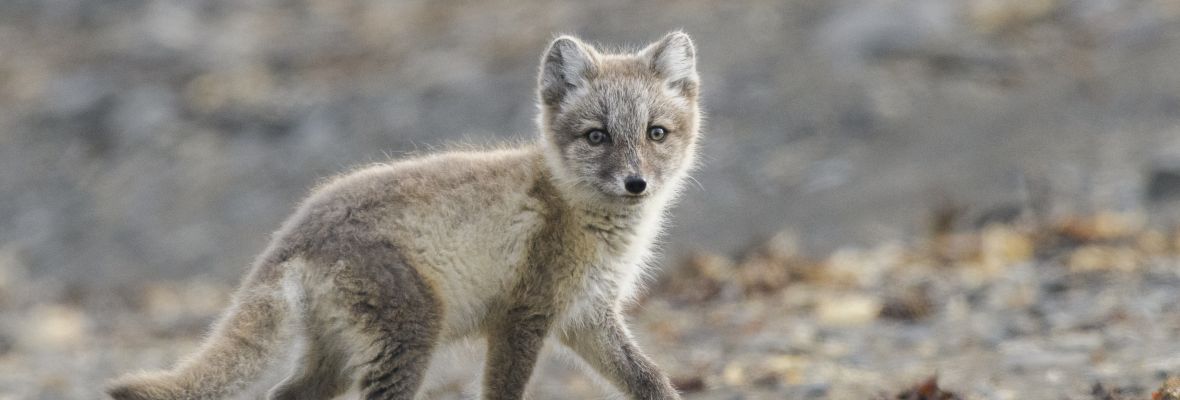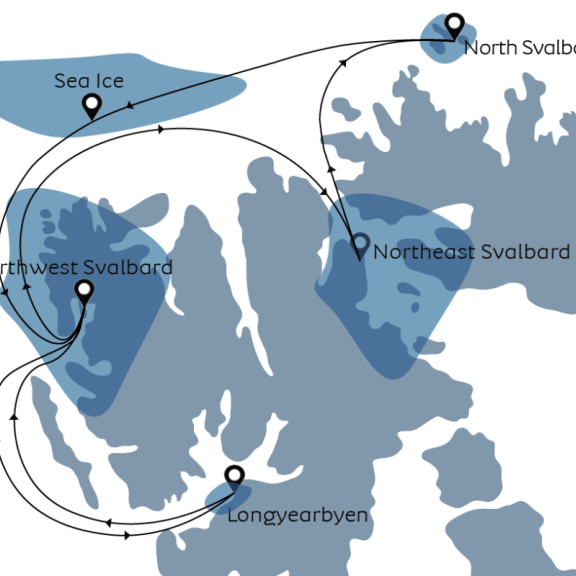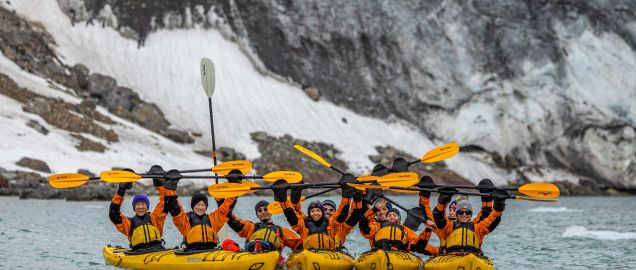Highlights of Svalbard
Enjoy the immense beauty of Svalbard on this "express" Arctic adventure cruise among whales, walruses, polar bears and millions of sea birds. Experience high summer in the Arctic with Ocean Albatros - one of the few ice-class expedition ships built to withstand the Arctic pack ice.
Embark on an incredible journey as you traverse through icy waters and landscapes in seven action-packed days. Get ready to explore and discover the unique ecology of this mountainous and glacier-clad island - and experience the true majesty of the high Arctic.
As we cruise up to 80 degrees north, we will get as close as possible to the pack ice north of Svalbard - a constantly shifting wilderness of ice and sea which stretches to the North Pole and beyond. This far north, everything is governed by the sea, wind and ice conditions - your expedition leader and Captain will work hard to fid the best conditions and opportunities to explore.
Onboard Ocean Albatros you will experience areas of Svalbard not easily accessible by any other means of exploration as we carefully navigate around this breathtaking archipelago. Our fleet of Zodiacs allow us to have frequent shore landings and embark on exploratory mini cruises in the fjords and glacial landscapes. From historical sites, to glacier fronts, to remote lonely beaches, no area is off limits to us!
During the short Arctic summer, wildlife such as reindeer and polar foxes are busy amassing energy for the brutal polar winter. Cliffs shimmer with life as every surface is populated with countless birds - Arctic guillemots, fulmars and razorbills can be observed fishing in our ship's wake. On the sandy shores, huge walruses bask in the midnight sun, and whales and seals forage along the edge of the pack ice. On the ice itself, we may even see the king of the Arctic, the polar bear, on its never-ending search for prey.
Showcasing the highlights of Svalbard in just seven action-packed days, this is an experience not to be missed. Experience with us!
Facts about Highlights of Svalbard
- Arctic
- Svalbard
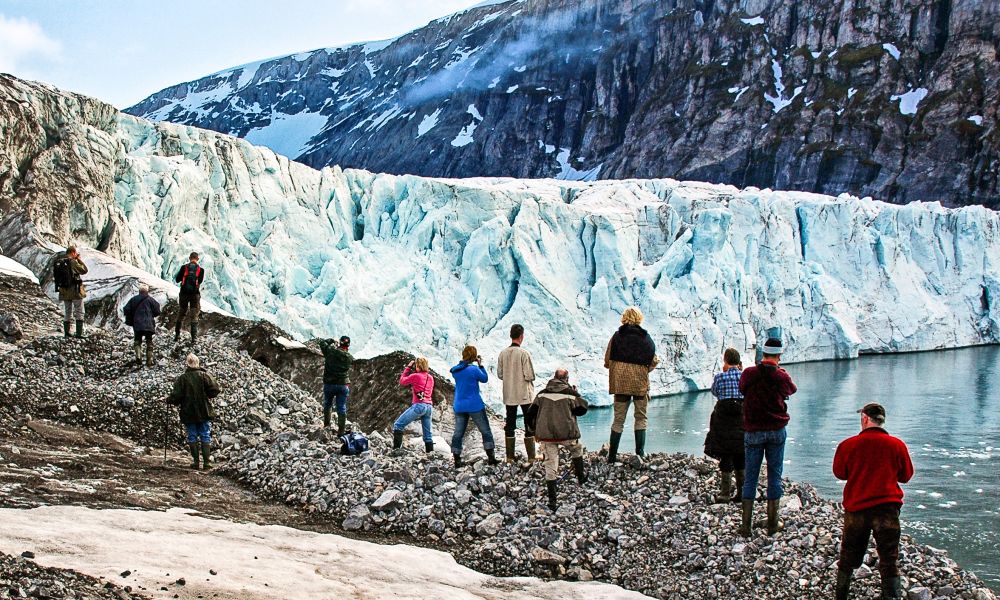
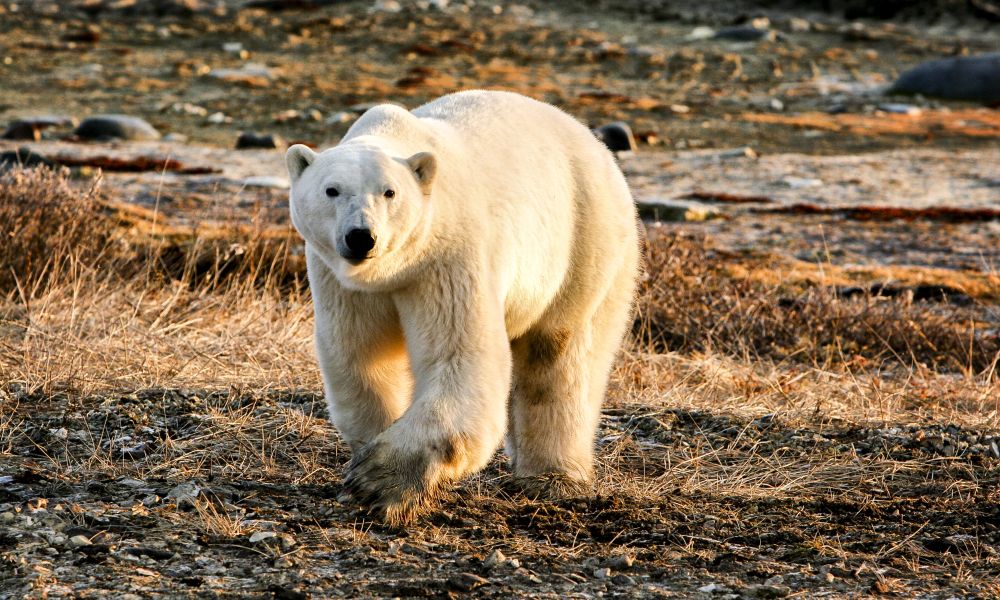
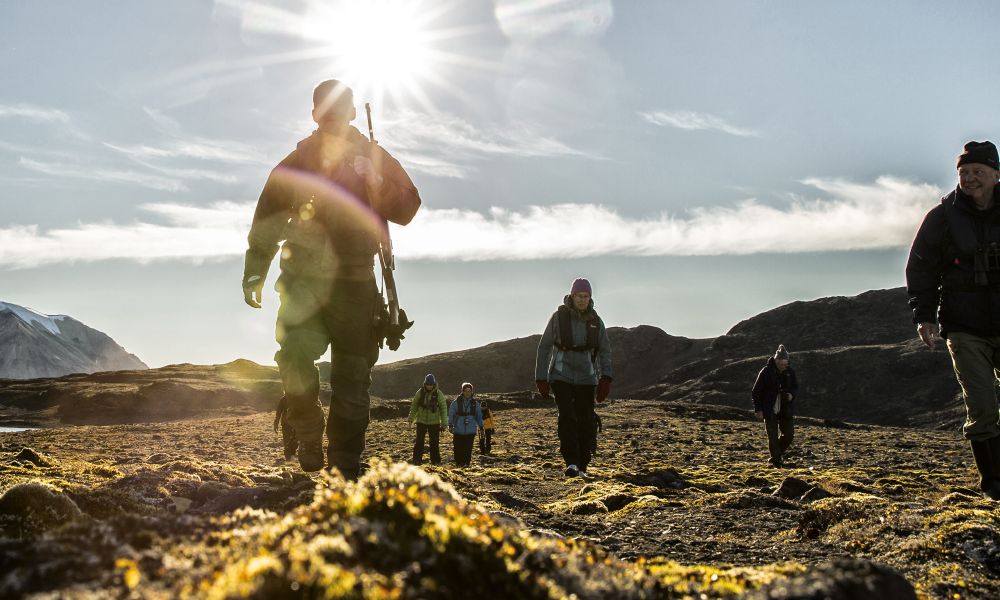

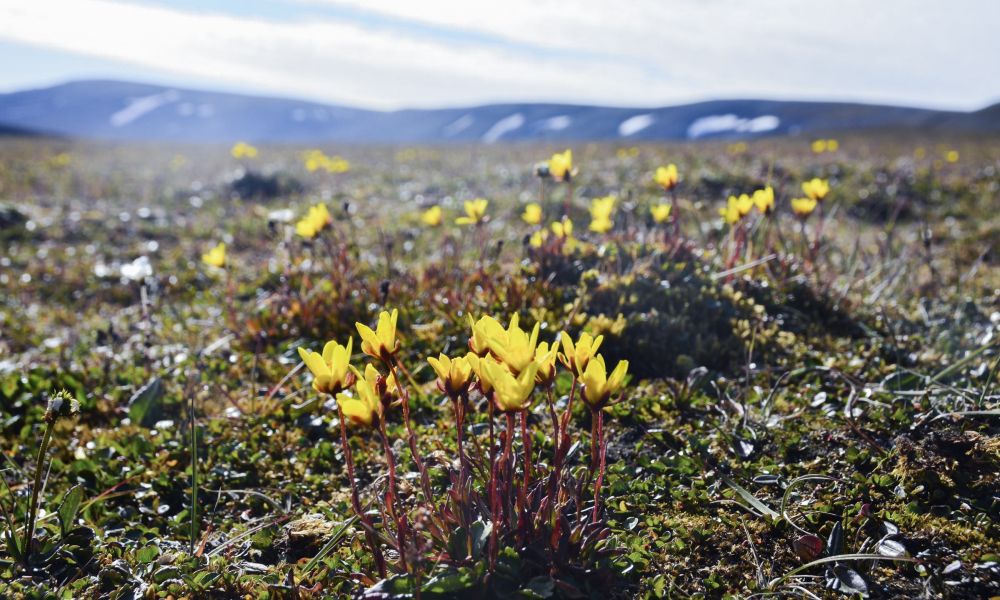
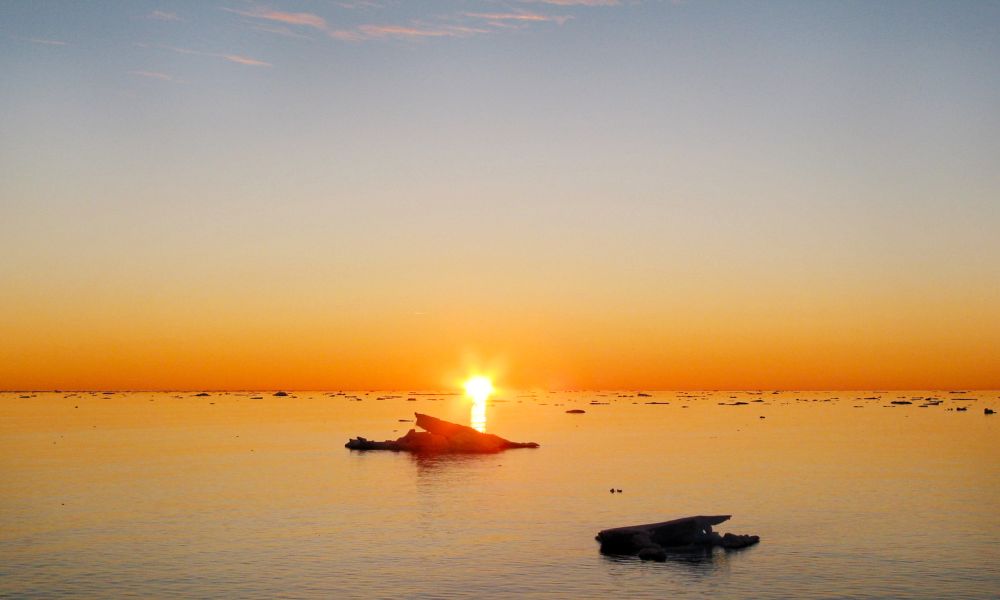
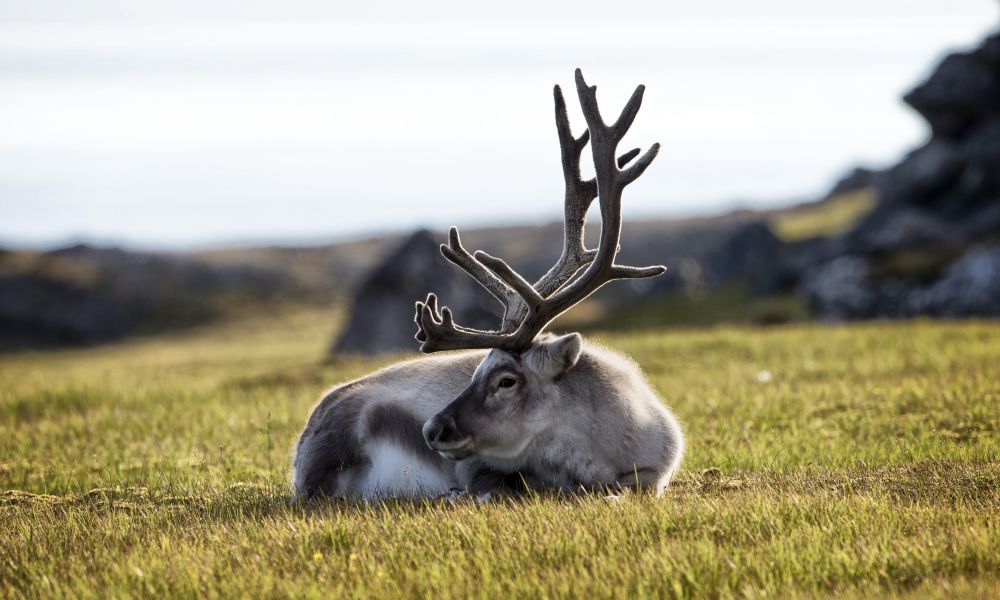
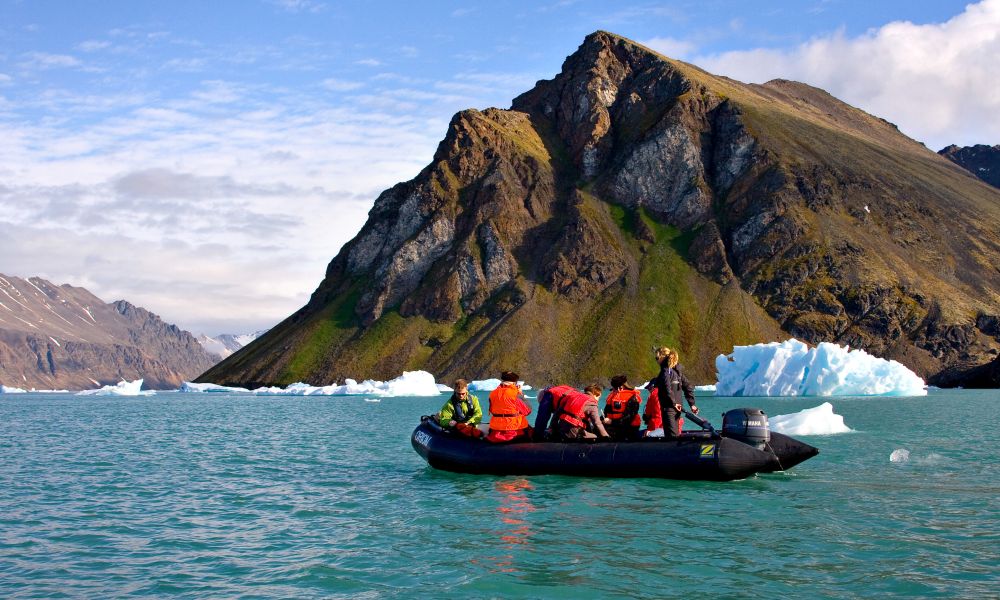
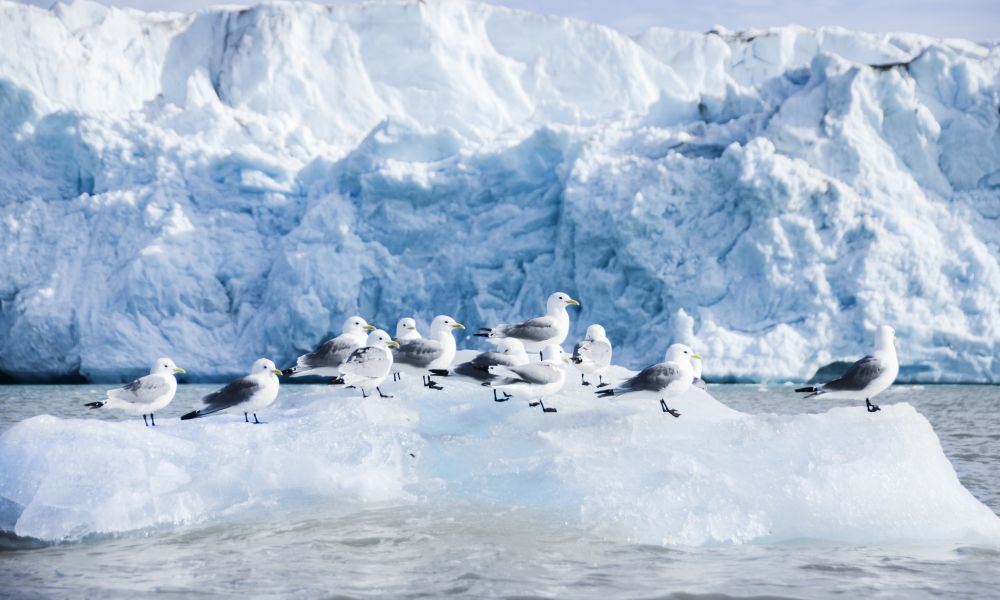


Day 1
Longyearbyen, Spitsbergen - Embarkation
Board your flight in Norway and arrive in Longyearbyen, Svalbard - the world's northernmost... everything! This remarkable little city is not only the northernmost town in the world (if one excludes the tiny research community of Ny-Ålesund, slightly further north on Svalbard), but also hosts the world's northernmost civilian airport, schools, bank and supermarket. The town's rugged frontier edge belies a core of warm Nordic hospitality and coziness - hyggligt, as we say in Denmark!
Immediately after landing in Longyearbyen, you find yourself in a different world. The chilly Arctic breeze can be felt as soon as you step onto the tarmac, and the famous signpost outside the terminal reminds visitors how far north they really are; as well as to keep watch for bears! The snow-capped mountain Hjorthfjellet looms over the airport on the far side of Adventfjorden, and off in the distance can be seen the saw-toothed peaks and languid glaciers of northern Spitzbergen.
After arrival, you will board the awaiting Ocean Albatros. After our mandatory safety briefing and lifeboat drill, head onto the outer decks to enjoy a glass of champagne while watching your expedition vessel leave civilisation behind... And set a course for adventure!
DAY 2
Northwest Spitsbergen
One of the largest protected wilderness areas in Europe, North West Svalbard was declared a national park in 1973. The area is famed for its history, which documents some of the earliest human arrivals on Svalbard. While Norse explorers may have sighted these icy shores during the Viking Age, the first definite arrival was the expedition of William Barents, the legendary Dutch explorer for whom the Barents Sea is named. While now protected from human distruption, when Barents arrived in 1596, he noted the vast numbers of whales and seals which were soon prey to English and Dutch whalers, who arrived within a decade of Barents to pillage the area's wildlife. The area occupied the triple point between land, sea and ice, and as such was the perfect location from which to harvest the gentle giants of the oceans. Sites used to dismember whale carcasses and render them for their precious oil include the Dutch settlement of Smeerenburg, where the remains of 16th Century blubber ovens and building foundations can still be seen. Other sites such as nearby Ytre Norskøya record the darker side of this industrialised slaughter, where hundreds of young men who hoped to make their fortunes are buried thousands of miles from home.
Today, all that remains from this period of history are bones and the scant remnants of human habitation. Slowly reclaimed by creeping Arctic nature, the region is now a nature lovers paradise. Tiny Arctic poppies and purple saxifrage defy the brutal conditions to flower in the brief summer, while geese, eider ducks and other seabirds return to the island to raise their young. Walrus can be found hauled out on beaches, and we must always be on careful lookout for wandering polar bears in this now again wild region.
DAY 3
Northeast Svalbard
In the morning we cruise into the vast icy wilderness of northeastern Svalbard. This region does not recieve the ocean currents which keep western Svalbard warm and wet, and thus the environment is radicaly different, with rocky polar desert landscapes. Vast glaciers flow from the mountains into the sea, which is often choked with ice, even in summer.
While it may appear barren, the truth is it is anything but. Hardy animals such as Arctic foxes eke out a living on these chilly shores, constantly on the lookout for prey. In the cliffs above the sea, hundreds of thousands of seabirds crowd on rocky ledges, carefully tending their precious eggs. While the coastal waters of the area are cold, they are incredibly productive; shellfish grown in abundance, and these in turn are preyed upon by walrus, which are common in the area.
The exact locations we visit will depend on the sea, wind and ice conditions in the area, which vary year on year, and can change rapidly even in summer - this is the essence of polar exploration, moving with the rhythms of Mother Nature, and taking the opportunities to explore which she provides!
DAY 4
North Svalbard
Now we reach some of the northernmost pieces of land on Earth - the northerly coasts of Svalbard, barren landscapes almost permanently beset by ice. With luck we may reach the island of Nordaustlandet and hopefully the seven (or nine, depending on how you count) smaller islands of Sjuøyane in the far north of Svalbard. The almost vegetation-free, rocky islands are located around 1000 km farther north than mainland Norway’s famous Nordkapp.
Weather permitting, we will land and walk upon these most northern landmasses. The high Arctic islands are quite barren, and only moss and lichens cover the stones. The birdlife is rich in this area, with flocks of grazing geese and some of the rarer gull species frequently seen on these islands. Definitely bring your binoculars!
At the end of the day, we will start cruising towards the Arctic ice pack, which stretches from Svalbard to the North Pole.
DAY 5
Into the Ice
An icy breeze touches your exposed cheeks. The scent of snow and sea fills your nostrils. Sunlight reflects off the floating ice, illuminating the clouds overhead. Enter an environment like no other, the vast shape-shifting realm of floating ice which crowns our planet. The vast ever-changing ice pack to the north of Svalbard stretches from this already isolated archipelago to the North Pole, and onwards across the Arctic Ocean towards the northern shores of Chukotka and Alaska.
The Arctic ice pack is one of Earth's largest habitats, although unlike most it varies hugely year on year, expanding in winter and retreating in summer. The location of the sea ice around Svalbard can also vary wildly - however, your Expedition Leader will work hard to maximise our chances of finding and exploring this impossibly remote environment. At first glance, this stark white wilderness seems barren, empty and lifeless. This frigid wilderness holds on to its mysteries, and of course wildlife sightings are at the whims of Mother Nature. With a little perseverance however, the ice reveals its secrets.
As Ocean Albatros pushes through the narrow channels in the ice, tiny cod-like fish can be seen silhouetted against the ice in the clear water. Kittiwakes and Gloucous Gulls follow the vessel as it distrubs the water. Further out on the ice, black dots appear; moving closer, they resolve into seals, basking on the ice. A plume of water reflects the sunshine - a pod of belugas perhaps, or maybe even the vast gentle bowhead whale crushing the ice from below as its massive body surfaces. There, beyond the banks of rucked ice - a yellowish dot pads along the ice, the head swinging from side to side: the King of the Arctic continues his never-ending quest for prey. This is the kingdom of the polar bear, the vast icy wastes at the top of the world.
DAY 6
Kongsfjorden area, Northwest Spitzbergen
During the ‘night’ (what is night, when the sun never sets?), Ocean Albatros will have repositioned past the saw-toothed mountains of Prins Karls Forland and arrived in magnificent Kongsfjord. Surrounded by craggy mountains, bounded by the magnificent Kongsbreen and Kongvegen Glaciers, and crowned by the Three Crowns (a set of pyramidal mountains said to represent the monarchies of Norway, Sweden and Denmark), this is surely one of the most beautiful and tranquil corners anywhere in the world.
Our first landing will be at the small settlement of Ny Ålesund. Situated further north than Longyearbyen, Ny-Ålesund is Earth's northernmost settlement, if a group of scientific stations, a post office and a single shop open for a few hours can be described as such... You will have to judge for yourself!
These islands' geographical location has made them the staging post for exploratory and scientific expeditions for centuries - a proud legacy which continues to this day. The setting is spectacular, and the scientific projects are as fascinating as the history of the town, which has hosted the Nobile, the Norge and the Fram, Amundsen, Nansen and Nordenskiöld, all legends of polar exploration who passed this lonely outpost seeking to push the boundaries of humanity. The remnants of these expeditions (such as the mooring mast of the Norge) can still be seen today.
Day 7
Longyearbyen, Spitsbergen - Disembarkation
On the final morning of our expedition, we arrive in Longyearbyen, Svalbard - the world's northernmost... everything! Even this small town will feel like a metropolis after days of splendid isolation in the wilderness of the Arctic!
After enjoying exploring Longyearbyen and a fond farewell to the crew and fellow guests of Ocean Albatros, return to Svalbard Airport and join your flight back to the Norwegian mainland- with memories to last a lifetime.
Inclusions
- 7-day/6-night cruise
- Cruise on Ocean Albatros in a shared outside double room with a private bathroom in the category chosen
- English-speaking expedition staff
- Guided walks with the expedition team
- Nature hikes and Zodiac cruises per itinerary
- Information briefings and lectures by the expedition team
- Full board on the ship
- Dinner drink package
- Free coffee, tea, and afternoon snacks on the ship
- Welcome and farewell cocktails
- Taxes, tariffs, and landing fees
- Digital visual journal link after the voyage, including voyage log, gallery, species list, and more
Exclusions
- Optional Transfer Package: Flights between Oslo - Longyearbyen - Oslo and Group Transfer between Longyearbyen Airport and the vessel. To be booked 11 months prior to departure at additional cost.
- Extra excursions and activities not mentioned in the itinerary
- Single room supplement and cabin upgrades
- Meals not on board the ship
- Beverages (other than coffee and tea and dinner-drink package)
- Tips for the crew (we recommend USD 16 per person per day)
- Personal expenses
- Travel, cancellation, and senior insurance
- Anything not mentioned under ’Inclusions’
Leaving Longyearbyen, your expedition vessel will proceed onwards into Svalbard to explore the unknown. The goal for the days spent exploring in Svalbard is to offer activities which will allow everyone to explore off the ship as much as possible (weather permitting). Weather dependent, we will try to offer two activities per day, usually either a landing or a Zodiac cruise.
Typically, there will be a morning activity after breakfast and an afternoon activity after lunch. We always try our hardest to meet this expectation, but because weather in the Arctic can be extremely unpredictable, we ask everyone to be mindful of our remote location and thank everyone in advance for their flexibility. Activities we offer include landings, Zodiac cruises and ship cruises. Regulations in Svalbard limit the number of people ashore at any time, so we will usually aim to offer a Zodiac cruise while our first group of guests are ashore, and reverse this for the second group ashore to maximise exploration time. No matter the day’s planned activities, the onboard Expedition Team and Expedition Leader will work as hard as possible in conjunction with the Captain and Crew to maximize exploration opportunities.
A “typical” expedition day may look like this (subject to weather and sea conditions and sailing schedule):
- 06:45: Wake-up call
- 07:00-08:00: Breakfast
- 08:30-11:30: Morning activity - Landing and Zodiac Cruise
- 12:30-13:30: Lunch
- 14:30-17:30: Afternoon Activity - Landing and Zodiac Cruise
- 18:30-19:30: Evening Recap with Expedition Team
- 19:30: Dinner
Landings are a great opportunity to stretch your legs and set foot on shore to visit the wildlife colonies, historical sites, and dramatic landscapes of Svalbard. Our experienced Expedition Team will be on shore to help you spot any wildlife, historical remains and geological and biological features, as well as keep our guests safe on shore from any potential hazards.
Remember that Svalbard holds a significant population of polar bears; while encounters are rare, these large wild animals can be dangerous. For that reason, when ashore in Svalbard our specially trained staff always prioritise the safety of our guests, and freedom to roam and hike in the area may be limited. We remind all visitors that this is for their own safety, and the safety of polar bears on Svalbard.
Some sites do not offer landing opportunities, but are locations where exploring on the water offers the best opportunities for sightseeing, wildlife and photography. These Zodiac cruise sites are often known for their concentration of ice, wildlife and even historical landmarks such as whaling stations, where our fleet of Zodiacs offer the best vantage point. This would be the only scenario you may have to wait on the ship (other than in adverse weather conditions), but we will always aim to offer an onboard program during this time, such as seminars given by our knowledgeable and experienced Lecturer team. Zodiac cruises are great for observing icebergs, glaciers, whales, and other marine wildlife. Your skilled driver will navigate around the area looking for wildlife and beautiful landscapes. By the end of the voyage, Zodiac cruises tend to become a firm favourite among our guests because of the vast diversity of scenery and marine life it is possible to experience.
In the event we encounter bad weather, are in a particularly spectacular location, or are viewing marine wildlife, often our purpose-built expedition vessels are the best viewing platform. The Captain and Expedition Leader will search for locations best accessed with the vessel to seek out the best wildlife and scenery. We encourage everyone to bundle up and either head onto the outer decks with the Expedition Team or relax in superlative comfort in our specially-designed lounges to experience the majesty of the Arctic from the best vantage point. During this time, our Expedition Team specialists will offer expert commentary related to the wildlife, history and conservation of the region, and more!
Other activities onboard include our ship Gym, where you can burn some calories on our fitness bicycles or treadmills; most of our ships even have other cardio machines and strength/lifting options. Most voyages throughout the season also offer kayaking (booked and paid onboard – weather permitting), and we will often aim to offer hiking excursions onshore when possible. Our new purpose-built ships have a Spa, in which guests can enjoy massages, facials, and other relaxing treatments (additional cost applies). Our Library is a great place to rest between outings, with expansive views and a wide selection of Arctic-related reading material. During your voyage you will also be able to enjoy our tea time in the late afternoon, or indulge in some retail therapy in our onboard shop, which sells personal necessities as well as specially-selected Arctic souvenirs.
In between our landings and activities we offer three hearty daily main meals. Albatros Expeditions always have allergy flexible options, healthy selections as well as a variety of vegetarian and vegan options.
Our hardworking galley crew deliver multiple Breakfast options, served in a buffet style along with a cooking station where eggs are made to order. At Lunch we are also met with a smorgasbord of mouthwatering choices. Safe to say you will have the energy for your next outing!
When it is Dinner time, you can choose to eat at the main restaurant or book a table at the Specialty Restaurant. Your evening meal is served a la carte, with fresh new options daily and always a selection of fixed items. There is always a vegetarian and pescetarian option available. Albatros Expeditions are known for our delicious menus and a variety of exquisite wine pairings.
Onboard you will also have the option to join Afternoon Tea with sweet treats, cakes or snacks served each afternoon. Albatros Expeditions have tea and coffee freely available all day throughout the vessel, while specialty coffee, alcoholic beverages and hand-crafted cocktails are available at the ship’s bars.
During May, migratory wildlife begins to return to Svalbard. Geese, wading birds, and seabirds arrive for their breeding season, constructing nests and defending their tiny but all-important territories. While Svalbard experiences the midnight sun from early April, during May, many of the fjords are still frozen, and snow reaches down to the sea. This can be an exciting time to spot migratory wildlife, although colder weather and more unpredictable weather can hamper exploration at times.
By June, most of the fjords of Svalbard are navigable, and the snow has retreated to the hills – although the pack ice to the North can still block off access to the colder northeastern part of the archipelago. The tundra begins to come to life, as saxifrages, Arctic willows and heathers start to photosynthesise, greening the otherwise stark Arctic landscape. Expect to hear cacophonous bird calls during June, as the archipelago’s bird life rigorously defend their nests from predators. Arctic foxes (one of the Svalbard’s major predators) have now lost their snowy winter coat and molted into their sleek smoky summer. By June, the female walrus of Svalbard have mostly given birth to their calves, which they nurture at sea - although they can sometimes be spotted on shore at some of the larger walrus colonies. Polar bears may be found throughout the islands, roaming the wilderness in their never-ending search for prey. On the hillsides, the stumpy Svalbard reindeer begin to give birth to their calves – a process which continues through July. While inclement conditions can occur in June, the rising temperatures and permanent sunshine offer excellent exploration opportunities as the weather becomes more stable.
In July, the brief Polar summer reaches its peak. The hillsides burst into colour as plants begin to flower – tiny jewels of purple and yellow adorning the tundra. July is the peak of animal activity on Svalbard, as the wildlife attempts to complete their breeding cycles and pack on enough fat to survive the brutal Arctic winter. Arctic fox cubs are emerging from their dens and beginning to explore the world, while their parents ruthlessly stalk prey to feed their young. On the sea cliffs, guillemot, fulmar and little auk chicks are emerging from their eggs, while goose, tern and eider chicks are hatching in their nests on the ground. The parent birds valiantly defend their nests from marauding foxes and even polar bears. This is a lean time of year for the King of the Arctic; polar bears stranded on Svalbard by the retreating ice live primarily off their fat reserves through the summer; the lucky ones survive by scavenging beached whale carcasses, while others will frequent bird colonies, hoping for unguarded eggs or chicks fallen from their nests, and some even resort to eating grass and berries.
rctic weather is famously unpredictable. Svalbard experiences midnight sun from April to late August, bringing with it warmer and calmer weather. Summer temperatures tend to range between 4-10°C (39-50°F); due to the constant sunlight, temperatures in summer rarely drop below freezing, although frost and snow showers can occur at any time.
Extended periods of sunshine can warm up sheltered areas significantly, and these can feel warm (even hot) on calm windless days. However, the weather in Svalbard is heavily influenced by the last gasp of warm water currents from the Gulf Stream, which can bring rapidly changing conditions. Fog, wind and rain can occur at any time, even on the warmest sunniest days, leading to rapid drops in temperature. We therefore remind our guests to be prepared for all weather conditions! We highly recommend to our guests to dress in layers (ideally in woollen or synthetic fibers) and wear a backpack so that layers can be adjusted as the weather dictates. Warm/waterproof layers, hats, waterproof gloves and scarves are recommended for all excursions off the vessel, even on the sunniest days – the weather can deteriorate rapidly at any time. Sun protection (hats, sunglasses, sunscreen and lip balm) is also essential – the low angle of the Arctic sun combined with cool ambient temperatures can cause sunburn to easily go unnoticed until it is too late!
Unlike many areas of the Arctic, Svalbard does not host mosquitos or other biting insects. Bear in mind however that mainland Norway does! Head nets, long sleeved clothing and repellant are essential if you plan on extending your visit!
Albatros Expedition strives to employ the very best Expedition Team in the whole industry. We travel in some of the planet’s most remote regions, where planning and on-location experience is key. Our routes and itineraries are subject to the prevailing sea, ice and wind conditions, which are closely monitored by the Bridge Team and Expedition Leader. Drawing on their vast experience, they find the best alternatives in the rare instances where our planned itinerary needs to be changed. Each cruise is a completely unique combination of locations, where the highlights can often be the totally unexpected. Most of our cruises provide the opportunity to spot a variety of unique wildlife, although this is subject to the whims of Mother Nature and can of course not be guaranteed. As you will no doubt experience, the joy from our Expedition Team when spotting different species on land or at sea is as genuine as your own.
This means that you as our guest are part of an adventure, a true expedition, where plans change, wildlife is encountered on their terms and your team consists of the very best experts within their fields. We strive to maintain a mix of specialists within relevant polar subjects including marine biology, ornithology, earth science, history and others. Albatros Expeditions boast a large number of Expedition Staff onboard, allowing us to maintain a high ratio of staff-to-guests at 1:8, amongst the highest ratios in expedition cruising. Some of our staff have decades of experience on ships or research stations, whilst others may be performing their first season. One thing they all have in common is the wish to make each and every journey a special and memorable experience for our guests. Knowledge, skill, and passion are the trademarks of all Albatros Expedition Staff.
To ensure the safety and quality of experience of our guests, please keep in mind that the itinerary and outdoor activities during each voyage are solely dependent on weather and sea conditions. Your safety is our highest priority. The route and shore landings will be determined by the Captain and Expedition Leader and communicated to guests through regularly scheduled briefings. Albatros Expeditions reserves the right to modify the landings and locations visited during a voyage based on local weather conditions and climate to ensure a safe and enjoyable experience for all our guests. Our voyages are expeditionary in nature, and thus changes to timings are commonplace due to the environment we operate in, as well as wildlife opportunities and locations.



